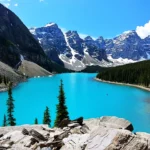Welcome to Muscat, a magical place where ancient ways meet the excitement of today’s world. This beautiful land, nestled between the blue Arabian Sea and the rocky Hajar Mountains, is just waiting to reveal its hidden gems and rich culture. Lose yourself in the lively Muttrah Souk, where colorful fabrics and mouthwatering spices fill the air, and don’t miss the stunning Sultan Qaboos Grand Mosque, a masterpiece of Islamic architecture. Getting to know Muscat is like taking a journey through history and culture, an experience you won’t soon forget.
Muscat’s Captivating Contrasts
Imagine a place where the endless Arabian Desert dramatically plunges into the sparkling turquoise waters of the Gulf of Oman. This is Muscat’s land, a captivating blend of ancient history, lively traditions, and awe-inspiring natural wonders.
Right in the heart of it all is Muttrah, Muscat’s bustling port district. Stepping into Muttrah is like stepping back in time. Narrow, winding streets burst with the scents of exotic spices, and vibrant stalls overflow with beautifully crafted handicrafts. You can almost feel the echoes of ancient traders and explorers as you wander through this captivating maze.
But Muscat isn’t just about bustling city life. Look up, and you’ll be greeted by the majestic Al Hajar Mountains, their rugged peaks piercing the clear blue sky. These mountains may hold secrets – tucked away amongst their slopes are hidden oases and ancient villages, just waiting to be discovered.
For centuries, Muscat’s strategic location along the Straits of Hormuz made it a global crossroads for trade. This rich maritime past is clearly visible in the breathtaking Sultan Qaboos Grand Mosque, a true masterpiece of Islamic architecture and a testament to Muscat’s prosperous past.
What’s fascinating about Muscat is how it effortlessly blends its storied past with its modern aspirations. Sleek, modern buildings stand tall alongside traditional whitewashed houses, showcasing the city’s constant evolution.
Imagine taking a relaxing stroll along the Muttrah Corniche, a picturesque waterfront promenade lined with swaying palm trees. As you breathe in the fresh sea air, the sweet scent of frangipani flowers fills your senses – a truly magical experience.
For a taste of Omani culture, the Royal Opera House Muscat is an absolute must-visit. This architectural gem hosts world-class performances that will leave you breathless.
As the sun begins to set, Muscat undergoes a mesmerizing transformation. The city is bathed in a warm, golden glow, and the white sandy beaches seem to shimmer under the starry sky. This is the perfect time to join the locals on the Corniche, where you can listen to their stories and experience the warmth of Omani hospitality.
Muscat’s land is a place of striking contrasts, where the old world meets the new, and the vast desert flows into the endless sea. It’s a destination that will captivate your senses, spark your imagination, and stay with you long after you’ve left.
Unveiling “Muscat Land”: A Crossword Clue and Its Significance
You might have encountered the term “Muscat land” while tackling a crossword puzzle. While it’s not a formal geographical term, it’s a popular way to refer to Muscat, the vibrant capital city of Oman, renowned for its ancient maritime history and modern-day charm.
Located on the Arabian Peninsula’s northeastern coast, Muscat has been a strategic port city and key player in the global trade network since the 2nd century AD, thanks to its position on the historic Maritime Silk Roads. Evidence suggests settlements existed in the area as far back as the 6th millennium BC in areas like Ras al-Hamra, showcasing Muscat’s long-standing connection to the sea. This strategic location in a cove made it a crucial port, connecting the East and West and facilitating the trade of goods like dates, mother of pearl, and fish along the Maritime Silk Roads. This historical significance is further solidified by Muscat’s inclusion in UNESCO’s Silk Roads Programme.
More than just a historical landmark, Muscat today boasts a unique blend of ancient and modern. Architectural marvels like the Sultan Qaboos Grand Mosque stand alongside contemporary buildings. The Muttrah Souk provides a taste of traditional Omani culture, while modern museums showcase the country’s art and history. While trade remains a cornerstone of Muscat’s economy, the growing tourism sector plays a vital role in diversifying the city’s economic portfolio.
Muscat: Unveiling the Charm of Oman’s Capital City
Muscat, the vibrant capital of Oman, is a city steeped in history. Often referred to as “Muscat and Oman” in the past, the city’s name reflects its historical significance and inextricable link to the country. Muscat is not just the biggest city in Oman; it’s the heart and soul of the nation, serving as its cultural hub, political powerhouse, and economic engine.
Situated on the Gulf of Oman coast in northeast Oman, Muscat is bordered by the Al Batinah Region to the west, Ash Sharqiyah Region to the east, Ad Dakhiliyah Region to the south, and the Gulf of Oman to the north.
Evidence suggests human activity in the Muscat area dates back to the 6th millennium BC. Historically, Muscat functioned as a coastal sultanate, expanding its influence through maritime trade and sometimes overseas expansion. “Oman” historically referred to the inland region with Nizwa as its capital. These two entities, Muscat (coastal) and Oman (inland), were distinct but interconnected. In 1970, the country officially became known as Oman, solidifying Muscat’s position as the capital of the unified nation.
Today, Muscat is a modern metropolis while preserving its cultural heritage. Visitors can explore historical landmarks like forts and souks, experience Omani culture, and enjoy modern amenities.
What Do You Call Someone from Muscat? Unraveling the Omani Identity
While residents of Muscat are broadly called Omanis, the term “Muscati” is colloquially used to denote someone specifically from the capital city. This distinction acknowledges the city’s unique character and the diverse cultural blend found within Oman’s capital.
Historically, “Oman” referred to the interior region, while Muscat, a coastal trading hub, had a more cosmopolitan identity. Today, while a unified nation, regional identities persist, with “Muscati” subtly acknowledging a connection to the capital’s unique history and culture.
Muscat is home to a diverse population, including native Omanis (representing various Arab tribes), and significant expatriate communities from India, Pakistan, Bangladesh, other Arab nations, and beyond. This diversity enriches the cultural landscape of Muscat but also adds complexity to defining a singular “Muscati” identity.
Beyond labels, the people of Muscat are known for their warmth and generosity, a hallmark of Omani culture. From vibrant souks and traditional arts to the importance of family and community, Muscat embodies Omani cultural values.
- Long Haired Gray Cat Breeds: The Ultimate Guide - April 7, 2025
- How Many Days Until Feb 2: Accurate Countdown & Tool Guide - April 7, 2025
- Uncover the 7th Month: A Deep Dive into July’s History - April 7, 2025
















